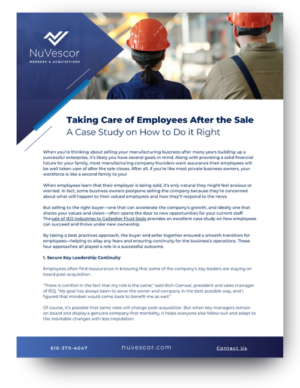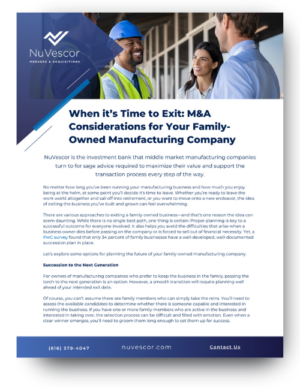
Selling Your Business in the Post-Pandemic Environment
NuVescor President Randy Rua highlights successful recovery strategies used by businesses after the events of 2020 and what to do if you need to sell your business but your financial performance hasn’t fully recovered.
1) Steps businesses have taken to recover from the events of 2020.
Businesses that recovered well after the pandemic were those that did not solely rely on PPP money to cover their losses but instead raised their prices and streamlined their costs. Companies that waited to raise their prices and/or cut expenses until after their PPP money ran out now have two years of poor financial performance and weak current financial performance, making it difficult to sell their business for a good price. Businesses that used PPP money for investments like equipment and expansion fared better than those that only used it to cover costs or losses. In summary, businesses that acted like they didn’t receive PPP money and made necessary adjustments to strengthen their financial health recovered better than those that did not.
2) The metrics used by buyers to determine your business value. Buyers are now focusing on comparing pre-COVID key metrics to current key metrics such as gross margin, labor cost percentage of sales, and year-over-year growth rate to understand how well the business has recovered. While EBITDA for the last three years remains important, buyers are now placing more emphasis on current performance and future projections due to the volatility of the past few years.
3) The recent downturn in financial performance has increased buyer demand for profitable companies. Due to the pandemic, half of the companies listed for sale are distressed or potential turnaround opportunities. Strong companies are now receiving a significant amount of attention from buyers since they are fewer in number.
4) How to address buyer concerns about recent financial performance. To sell a business that has poor financial performance, it is important to show buyers a clear path to improvement, such as increasing pricing, cutting costs, or investing in new equipment. If a buyer cannot see a way to improve financial performance through implementing improvements, they are unlikely to purchase the business. It is also essential to find a buyer with the necessary skills, resources, and abilities to make the necessary changes. Finding this buyer is crucial to selling your business if you don’t have strong financial performance.
5) The factors that potential buyers look at when evaluating a business have changed post-pandemic. Buyers used to be fixated on a company’s EBITDA performance over the last three years. However, due to the pandemic, they are now looking at a company’s current profitability, cost metrics, and market demand to understand its potential for improvement. For performing companies, buyers are looking at the EBITDA for the last twelve months as the primary factor to determine the company’s value.
In the current market, it is not necessary to wait until 2024 or 2025 to have three good years of numbers to sell. Due to the pandemic, there are fewer good businesses on the market, so if a company is currently performing well, it is recommended that they consider selling now.
Companies that are not doing well need to make changes quickly or find a partner that can help them. NuVescor can assist in selling to a buyer who can make the necessary changes to get back to solid financial performance. The market is volatile, and to transition a business successfully extensive research to determine value and find the right buyer match is crucial.
If you need help with selling your business, NuVescor can help. Click here to get in touch with us.







Recent Comments